My winter freight car work actually began last July.
I didn’t get any modeling done all summer with the kids home from college. However, in July, I managed to break away from the fam for a few hours and attend the St. Louis RPM in nearby Collinsville, Illinois, where I gave a talk about building small layouts. I spent most of Saturday horsing around with old friends Greg Davis and Tom Christiansen. Greg was in the Army and during Desert Storm so we always have more to talk about than trains. Tom brought a huge display of FGE cars and we sat at his table for an hour or two and caught up.

During the course of the conversation Tom gifted me the car below. This is a heavily-kitbashed Accurail car, rebuilt to model one of FGE’s first series of plug-door insulated cars. Note it does not have ice hatches. Tom said this model was 10-inches too short for the prototype and wanted to know if I would like to take it. I said yes of course, and the car now resides in my basement. I have wanted a pre-1950 plug-door car for my car fleet for a long time and thanks to Tom I now have one.

Here’s a prototype picture from Bill Welch’s collection. I will need to cobble together decals from National Scale, K4 and Mark Vaught to get it done.
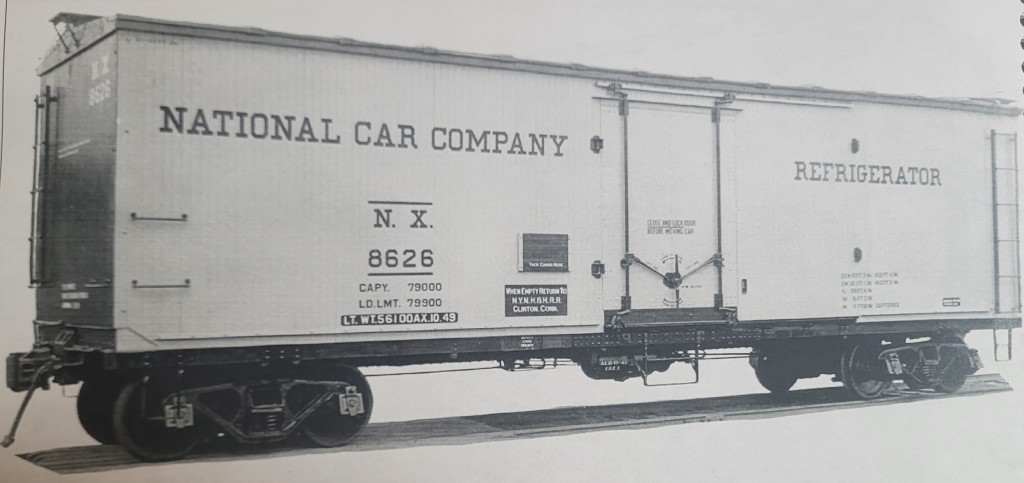
Meanwhile, in October, Charlie Duckworth asked if I could sandblast a 20-year-old Sunshine Models T&P box car for him because he wanted to repaint it. Charlie sent me the car, along with a gift–a Sunshine Models mini-kit to modify a three-bay offset hopper into one of MoPac’s cool home-made covered hoppers.
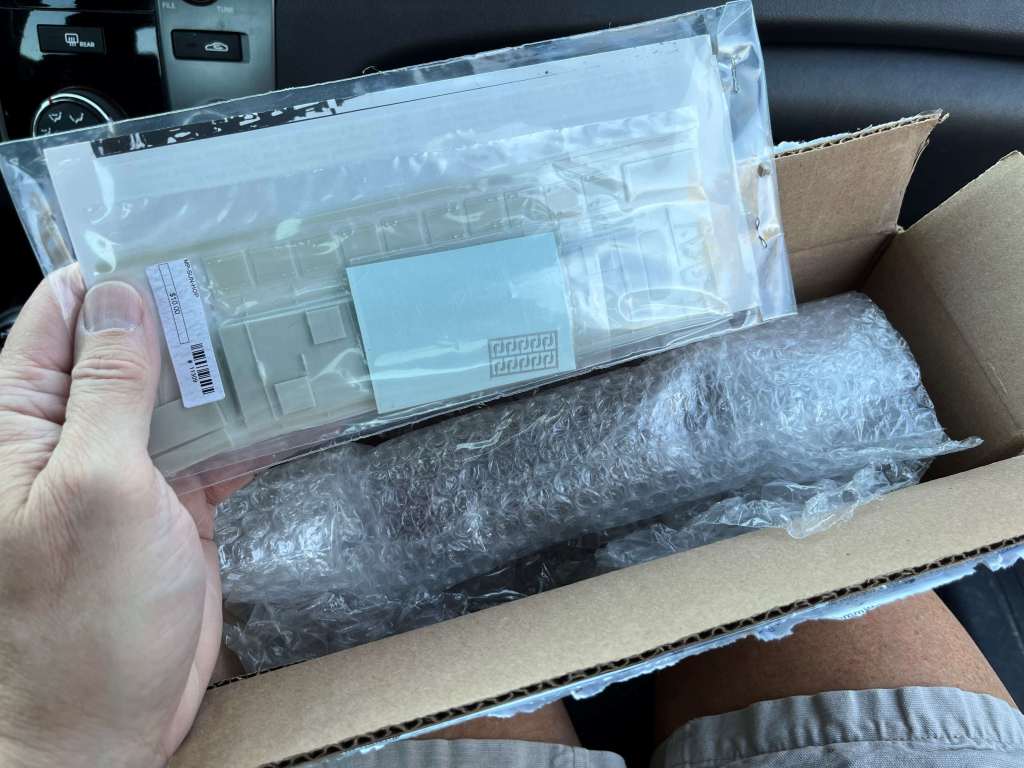
Here’s the car right out of the box on my layout. I think it looks pretty good as it is.

Here’s the old man blasting away in the garage. I should have a mask on!
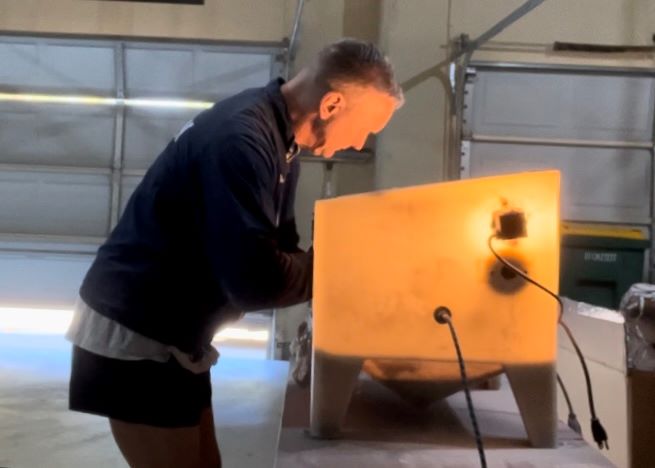
After a whole 15 minutes of blasting, here’s the car ready for a wash and new paint. I got the car on Friday, blasted it on Saturday, and sent it back the following Monday or Tuesday.

About ten days later Charlie posted this photo on the Steam Freight Cars site. Less than a week after getting the car back he painted, decaled and finished it and it was already back in service on his railroad. Man, he works fast. Note behind this car is his new MoPac cement car–the same car he sent me the kit for. He built that already too!

Another new car on my railroad is the Rapido Union Pacific B-50-39.
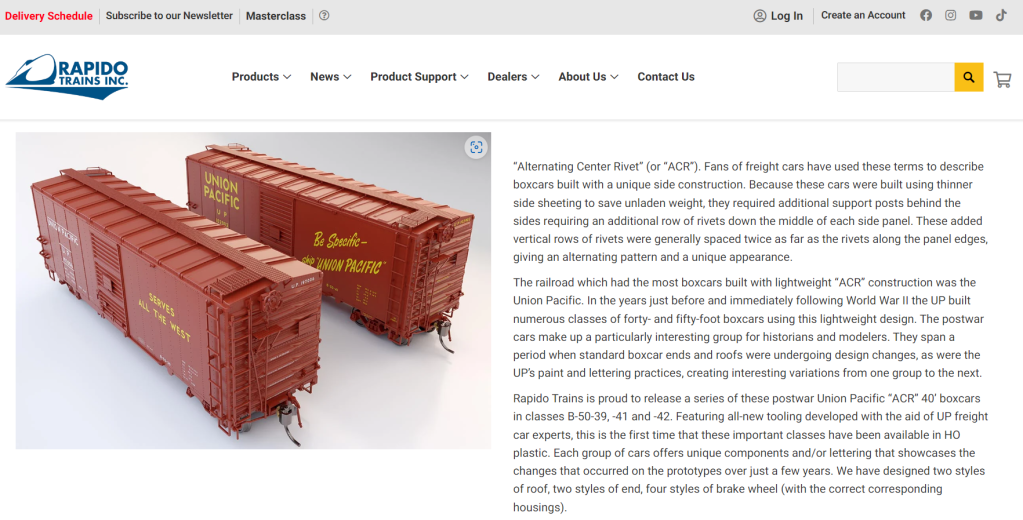
Some of the guys on the Steam freight cars list panned this model, but I think it’s beautiful. I think the alternate center rivets look great. The running board is good, the stirrups are metal pieces and are finely crafted and many of the other details are really nice. Sure it could use a few minor upgrades and improvements, most notably to the brake gear and the lateral running board attachments, but I left the model just like it is. I replaced the trucks with Tangent Barber S-2 trucks with semi-scale wheelsets and changed out the couplers for Kadee “scale” couplers, but that was it. Well done, Rapido guys. I am beside myself waiting for the Enterprise covered hoppers.
Since most of my freight cars are weathered to some degree or another and I thought it’d be nice to have at least one new-looking car. Therefore my weathering plan for this model was to leave it “new” and moderately weather the trucks and underframe. I did so by applying AIM Products Dark Rusty Brown to the Tangent trucks and underframe, ends and couplers. Lately I’ve been applying weathering powders on my work bench in an old baking sheet–that works nicely to contain the mess, AND its easy to clean.

Here’s the car on the layout…

Finally, here’s one new model I finished recently. Illinois Central rostered a large fleet of 1937 Modified box cars and I wanted to add one to the car fleet. These cars were about as plain-jane as they came. The photo below is from the old Mount Vernon 1942 catalog.

Below. Here’s my finished car on the Hermitage Road layout.

Illinois Central ordered six series of 1937 Modified box cars between 1939 and 1940. Here’s an excerpt from Ed Hawkins’ 1937 Modified Box Car list, published on the Steam Freight Cars site, which can be found here: http://steamerafreightcars.com/index.html

My model represents a car from the 19500-19999 series, built by Mt. Vernon in 1940. Mt. Vernon isn’t too far away from my home in O’Fallon so having a model of a car built there is nostalgic. I made my model from an old Intermountain kit but I substituted a lot of aftermarket parts, including:
Underframe:
- Cal Scale brake gear set
- Tichy AB Valve, turnbuckles (for attachments to the brake gear clevises, and .0125 wire for air brake piping
- Kadee #178 couplers, and Vulcan “HCG” trucks with semi-scale wheelsets
- Smokey Valley scale coupler pockets
- Yarmouth YMW-202 Stirrups
Sides:
- National Scale Car Co. Tack Board set
- Kadee bracket grab irons (holes drilled using the Yarmouth YMW-502 Template)
- Tichy .015 wire for roping loops
Ends:
- 5/5 Square Corner End YMW 1237E)
- Tangent Apex “High” PS-1 brake gear housing, Apex brake wheel and Coupler Lift Bars
- Hi Tech No. 6040 air hoses with brass mounts
- Yarmouth Retainer Valves (YMW 0060)
- Kadee bracket grabs
Roof:
- Yarmouth laser-cut 40′ wood running board with laterals and etched brackets (YMW-255)
I also used a generous amounth of Yarmouth Eyebolts (No Collar) around the car to fix piping, grabs, lift bars, and grabs. The Yarmouth part, YMW-500, is the best and most economical part on the market–you get about 40 of them on one fret for four or five bucks.
I built the car in the usual manner–underframe and brakes first, then ends, then sides, and finally the roof. Here’s the model with all those darn parts applied:

I really like the Yarmouth laser-cut running board. It was easy to apply and the lateral running board supports allow the laterals to be applied quickly. Below, I used canopy glue to secure the running board and taped it down until the glue set. I slid a piece of cardstock underneath the lateral support to ensure proper spacing until the glue set the laterals in place.
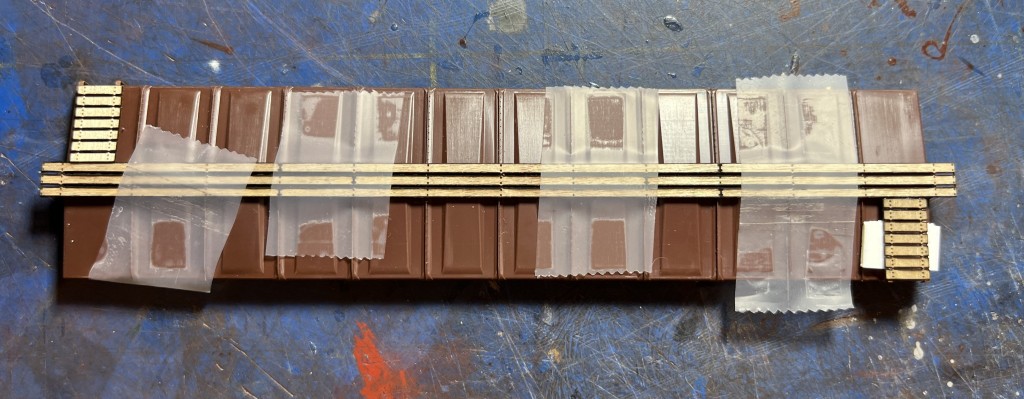
Below. Here’s a photo of how I attach the Kadee bracket grabs. The Yarmouth template makes it easy. I tape the template in position and leave it there, and drill right through the tape and holes with a #76 drill.
You can also see I had a little difficulty getting the flat back of the Yarmouth end to square up to the Intermountain car side.
Yarmouth has so much useful stuff. You can order these Yarmouth parts and many, many more at https://www.yarmouthmodelworks.com/index.php/Home/Index.

The view below is a close-up of the car corner, showing some of the details added such as Kadee grabs, the roping ring, the stirrups, and so forth. The Kadee Vulcan trucks in the HGC (Heavy Grade Compound) material are really beautiful.
When construction was complete I sandblasted the model to clean up the finish and etch all those pesky metal and delrin parts so they will hold paint. Once the car was washed and dried, I painted the entire model including trucks with Tru Color TCP-165, Illinois Central Brown.
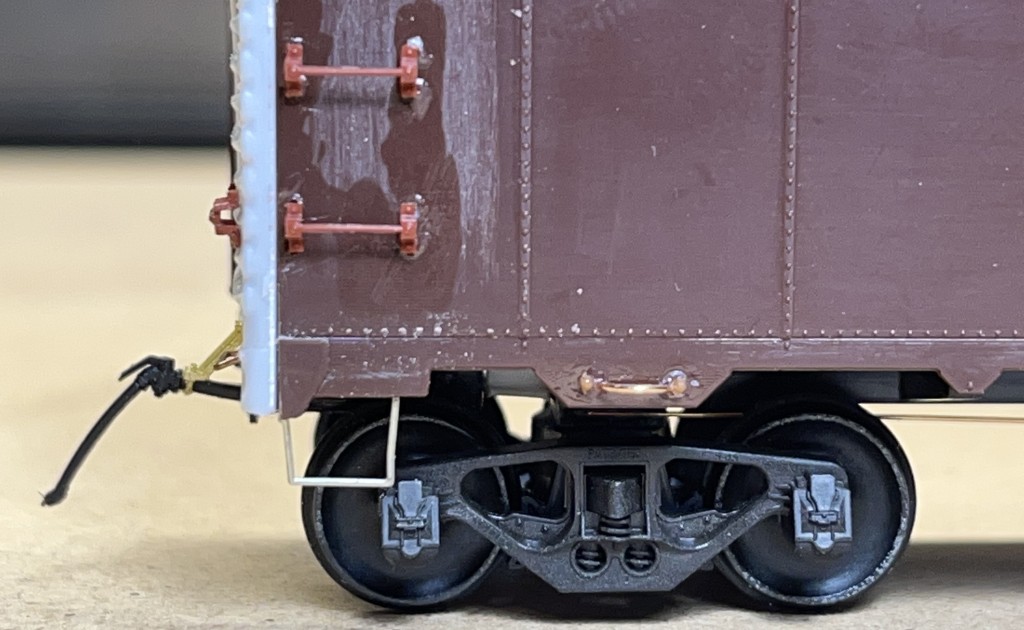
Decals are by K4. After the car was decaled I gave it a few light coats of Dullcote and then dusted the trucks, underframe and ends with a little AIM Light Brown weathering powders. Like the UP car I wrote about earlier, I wanted this to be a newer car so I didn’t over-weather it.
When I was building this blog post I noticed in the photos that I forgot to fix the running board end support on this end (below) and I totally forgot to attach one on the B end. What a Rookie Mistake. Back to the workbench it goes.
Here’s a few pictures before it heads to the RIP track. I think it turned out pretty nicely.

And here’s one more…
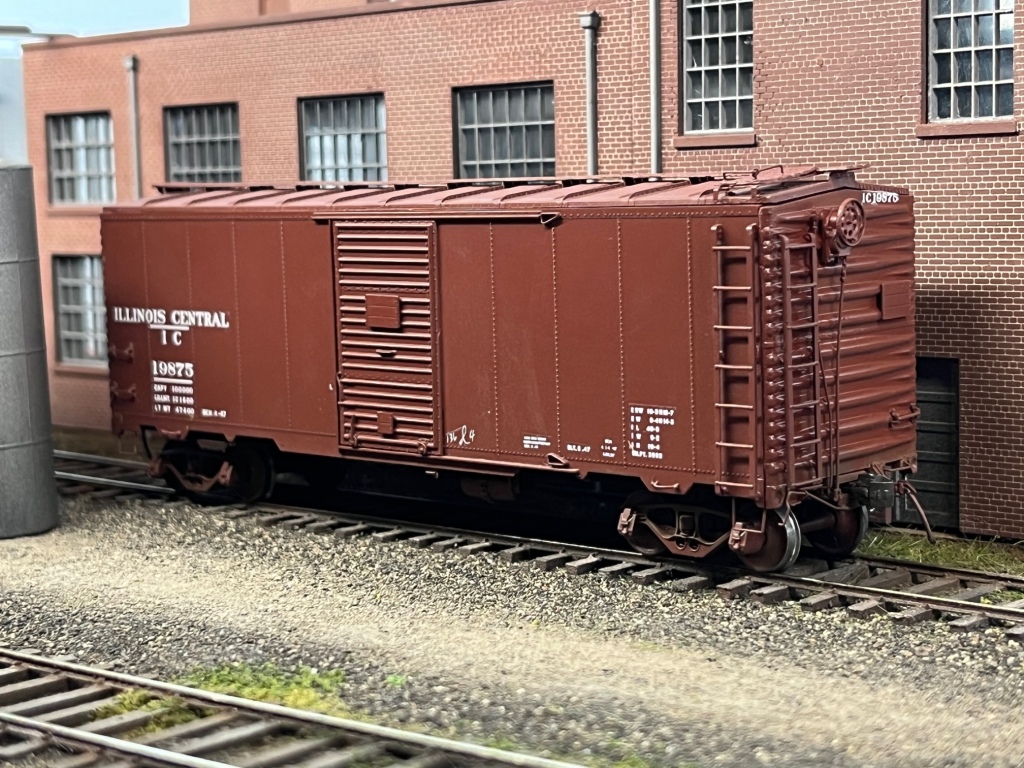
I was inspired to finish my car after seeing a few excellent examples at Naperville RPM in October 2023. The model below is by master-builder Ed Rethswich.

I didn’t record who built the model below, but I think it was Lonnie Bathurst. I found this one inspirational too, and it’s from the same car series as my model.
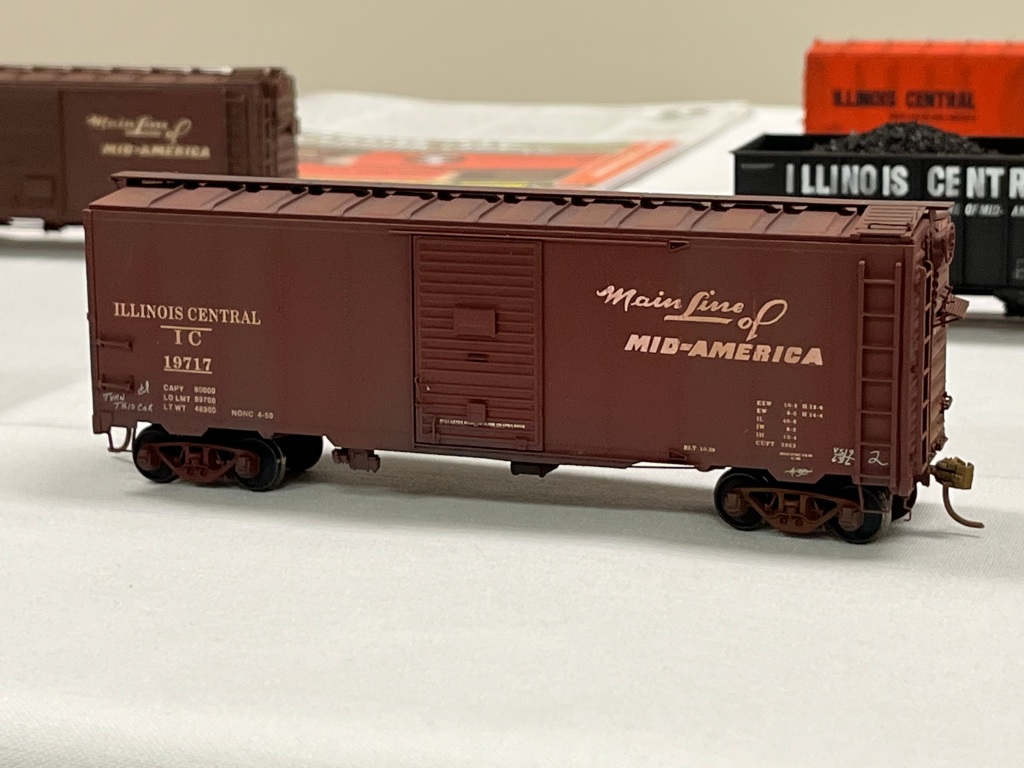
There’s another 12 cars on my “Finishing” list and I spent the long weekend in February working to get them done. Some of the new cars are shown below. There’s nothing too extraordinary about them–a few Westerfield cars, a Red Caboose CGW box car and a rebuilt Proto tank car to name a few. The notable exception is Rock Island 140714, shown below, which is a Sunshine Models 1923 car which came from Larry Sexton’s estate. I’ll write more on these models when I can find the time.

I hope you are all having a fun and productive week! – John Golden